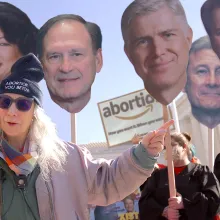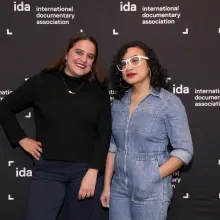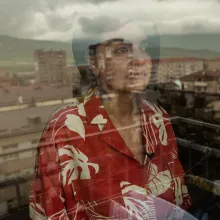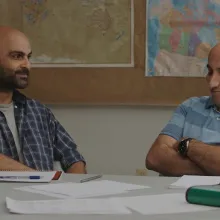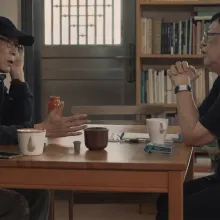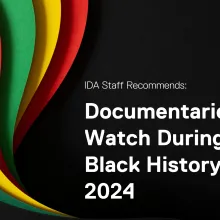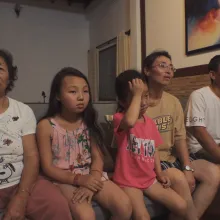Xiaolu Wang was born between the Yellow River and the Helan Mountains to a family estranged from their own Hui Muslim traditions. As a teenager, they followed their mother’s footsteps as immigrant settlers to Turtle Island and, since then, drifted around the homelands of the Anishinaabe and Dakota peoples. Xiaolu’s work has been screened at friends’ pop-up food projects and living rooms, Images Festival, Mimesis Documentary Festival, Taiwan International Film Festival, Courtisane Festival, and Tacoma Film Festival. They infrequently contribute to Mn Artists, a critical arts writing platform of
Latest Posts
I had been given such a wide breadth of opinions, suggestions, thoughts on Sundance that it felt a bit like I walked into somebody else’s IG story when I set foot in Park City for my first in-person attendance of the largest “independent” film festival in the U.S. I’ve mostly known Sundance as a beacon of mainstream acclaim and approval for filmmakers. Last year, Sundance provided a sense of discovery and excitement when I viewed its virtual programming. I felt inspired seeing the revelatory works of Raven Jackson ( All Dirt Roads Taste of Salt ), D. Smith ( Kokomo City ), Jeron Braxton (
Documentary is happy to debut an exclusive clip from Ruth Leitman’s No One Asked You, which follows The Daily Show co-creator Lizz Winstead on her 2017 “Vagical Mystery Tour, which spanned 16 Southern and Midwestern abortion battleground states, many of which are featured in this clip,” according to Leitman. This timely doc is continuing its festival tour after a world premiere at DOC NYC last fall, with special impact screenings planned in U.S. states where there are abortion constitutional amendments on the ballot, including Florida, Missouri, Colorado, Arizona, and Nebraska. Next, it plays
How can I upgrade my membership? To upgrade your membership, simply purchase your desired membership level here . Your new membership will begin at the expiration of your existing membership. You can start using your upgraded membership benefits immediately. I Upgraded my membership but don’t see the new membership reflected on my account. Our portal might not reflect your most up-to-date membership history. Please contact our team at membership@documentary.org , and our team will be able to assist you. I purchased the membership upgrade, but the expiration date is incorrect. Please contact
Documentary is happy to debut an exclusive clip from Emily Mkrtichian’s documentary There Was, There Was Not , which will world premiere at True/False on Thursday. Like IDFA 2023 winner 1489 , this feature concerns the Artsakh (Nagorno-Karabakh) region, where a declaration of independence caused violent conflict between Armenia and Azerbaijan, which currently claims the breakaway state. There Was, There Was Not follows four women intimately through the events of the recent past. On the clip, Mkrtichian writes, “Sosé Balasanyan, one of the four women in the film, is getting her hair braided by
Had it not been for a spiraling rift that began with a pro-Palestinian protest on the opening night of last year’s IDFA, Armenian director Shoghakat Vardanyan’s 1489 surely would have been the big story out of the fest. It’s an unassuming debut by a first-time filmmaker who took the IDFA’s top prize for best film in the international competition. Regardless, it was a bittersweet win that could likewise be read as a consolation prize, as 1489 is a doc that Vardanyan certainly never wanted to make. Its coldly bureaucratic title refers to the number assigned to a “body of an individual missing in
Softening the boundaries between fiction and nonfiction, the films of French-Canadian director Antoine Bourges are marked by their hybrid nature and his collaborative approach with participants. Whether in Vancouver’s Downtown East Side or Toronto’s Thorncliffe Park, Bourges captures everyday details of the surroundings he finds himself immersed in, introducing individuals and communities in the margins to the big screen with care and curiosity. Growing up in the neighborhood adjacent to the one depicted in Bourges’ latest, Concrete Valley (2022), I was amazed by his portrayal of a vibrant
A publicist for the International Film Festival Rotterdam (IFFR) remarked to me near the end of this year’s festival that after two years of the COVID-19 pandemic forcing the festival online and last year’s tepid restart, this was the “real” first festival under the artistic directorship of Vanja Kaludjercic. When Kaludjercic came aboard in February 2020 from MUBI, where she was director of acquisitions, there was talk that Kaludjercic might pare down the festival’s enormous lineup, which featured 575 films in Bero Beyer’s last edition. Now that we are as removed from the COVID pandemic as we
Celebrating Black History should not be limited to just one month! We must celebrate, honor, cherish, and uplift the voices and works of Black non-fiction makers, thinkers, scholars, and workers in our industry every day.
Since Beyond Utopia debuted at last year’s Sundance, where it won the Audience Award for U.S. Documentary, the film has screened at film festivals around the world and garnered acclaim for its portrayal of two families defecting from North Korea. It was shortlisted for an Oscar and most recently won a duPont-Columbia Award. But when we learned that the film would air nationally on PBS on Independent Lens on January 9, 2024, we were concerned. While the film’s verité sequences of the Roh and Lee families’ plight are compelling, the film simply points to the North Korean government as the


